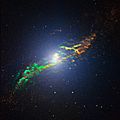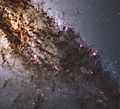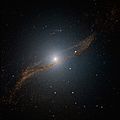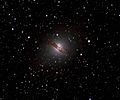Centaurus A facts for kids
Quick facts for kids Centaurus A |
|
|---|---|
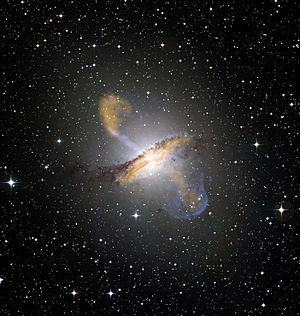
Centaurus A (NGC 5128)
|
|
| Observation data (J2000 epoch) | |
| Constellation | Centaurus |
| Right ascension | 13h 25m 27.6s |
| Declination | -43° 01′ 09″ |
| Redshift | 547 ± 5 km/s |
| Distance | 10–16 Mly (3–5 Mpc) |
| Type | S0 pec or Ep |
| Apparent dimensions (V) | 25′.7 × 20′.0 |
| Apparent magnitude (V) | 6.84 |
| Notable features | Unusual dust lane |
| Other designations | |
| NGC 5128, Arp 153, PGC 46957, 4U 1322–42, Caldwell 77 | |
| See also: Galaxy, List of galaxies | |
Centaurus A (also known as NGC 5128) is a very famous galaxy found in the constellation called Centaurus. A Scottish astronomer named James Dunlop first saw it in 1826 from his home in Australia.
This galaxy is quite close to Earth, about 10 to 16 million light-years away. It's one of the brightest galaxies we can see in the night sky. This makes it a great target for people who enjoy looking at stars and galaxies with telescopes.
Centaurus A is a special type of galaxy. It is either a lenticular galaxy (shaped like a lens) or an elliptical galaxy (shaped like a stretched ball). It's also known as a radio galaxy because it sends out strong radio waves.
Contents
What Makes Centaurus A Special?
Scientists have learned a lot about Centaurus A. They discovered that it is actually crashing into and "eating" a smaller spiral galaxy. This huge cosmic collision has caused a lot of new stars to form very quickly. Galaxies where many new stars are born are called starburst galaxies.
The Giant Black Hole
At the very center of Centaurus A, there is a giant supermassive black hole. This black hole is incredibly heavy, weighing as much as 55 million of our Suns!
This massive black hole shoots out powerful streams of energy and particles, called relativistic jets. These jets can be seen in X-rays and radio waves. Scientists have watched these jets for many years. They found that the inner parts of the jets are moving at about half the speed of light! When these jets hit gas around the galaxy, they create even more energetic particles. The radio jets from Centaurus A are incredibly long, stretching over a million light-years into space.
Seeing Centaurus A in the Sky
Centaurus A is a fantastic sight for anyone interested in astronomy. It's located about 4 degrees north of a bright star cluster called Omega Centauri. You can even see Omega Centauri without a telescope!
Because Centaurus A is so bright and looks quite large in the sky, it's a perfect object for amateur astronomers to observe. Even with binoculars or small telescopes, you can see its bright center and a dark band of dust running through it. With bigger telescopes, you can see even more details. If the sky is very clear and dark, some people can even see Centaurus A with just their eyes!
Images for kids
-
The radio galaxy Centaurus A, as seen by ALMA
-
The heavily obscured inner (barred?) spiral disk at 24 μm as shown by the Spitzer IR telescope
-
Chandra X-ray view of Cen A in X-rays showing one relativistic jet from the central black hole
-
"False-colour image of Centaurus A, showing radio (red), 24-micrometre infrared (green) and 0.5–5 keV X-ray emission (blue)
See also
 In Spanish: Centaurus A para niños
In Spanish: Centaurus A para niños




